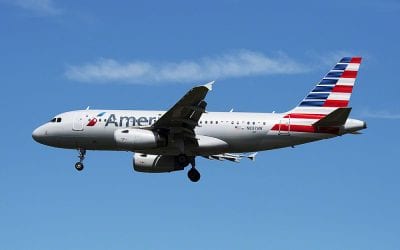Make your family air travel problem-free through planning and preparation.
 Irish poet and playwright Oscar Wilde said, “To expect the unexpected shows a thoroughly modern intellect.” That precisely defines what’s needed to make family air travel problem-free
Irish poet and playwright Oscar Wilde said, “To expect the unexpected shows a thoroughly modern intellect.” That precisely defines what’s needed to make family air travel problem-free
From personal experience, I know that while family travel dramas and hurdles will occur on almost every trip, planning, preparation, and a willingness to deal with the unexpected can overcome them.
Here are my top 17 tips for family air travel with young children.
Join TSA PreCheck. It can help smooth your trip significantly.
 Travel Documents:
Travel Documents:
When traveling internationally, if both parents aren’t on the family trip, or if you’re the children’s legal guardian, have a notarized document that shows that you have permission to have the children travel with you. This is especially important for divorced parents. Visit the USA.GOV International Travel Documents for Children page for help, but I recommend parents and guardians consult with an attorney practicing family law.
In addition, for international travel, don’t forget that your children need the same travel documents you need. Even babies need a passport for international air travel.
TSA PreCheck:
To reduce the hassle of airport security in the U.S., join TSA PreCheck. While it will add some expense to your trip, you can use it any time you fly, PreCheck can dramatically reduce waiting times and difficulties at airport security if you’re not already a member. Generally, your children can use it when traveling with you without additional charge.
Book your flights in advance. It can help you get assigned seats, seats in the right location, and the best flight times for your children. It can also give you a chance to book helpful layovers.
Book all your children in their own seats:
Children under two years of age aren’t required to have a seat of their own while flying; however, as the FAA states on their website in the Flying with Children section, “Your arms aren’t capable of holding your in-lap child securely, especially during unexpected turbulence.” According to the FAA, unrestrained lap children are the top cause of pediatric injuries on airplanes. If you’re traveling with a child under two years of age, I highly recommend that you book a seat for them and belt them into an approved child safety seat. It costs more, but it’s immeasurably safer.
For older children still traveling in car safety seats while being driven at home, bring that seat for the plane. Make sure your car safety seat is also approved by the FAA.
In-flight, keep your entire family, including you, belted in their seats — even when sleeping — whenever in the seats, in case turbulence hits your flight.
Book the right seats:
You’ll likely have to book early to ensure you have assigned seating on your flights, but when traveling with children, it’s important for families to sit together. Most airlines have free family seating; however, most of the time, families who don’t reserve assigned seats in advance will most often be seated together in the worst seating on the plane, likely in basic economy and/or next to lavatories and other noisy locations.
We always tried to book window seats for our kids, if possible, as looking out a window distracted them for long periods of time. On the other hand, we recognize that other children might be fearful of looking out of a window in-flight. You have to know your children.
Book the right flight time
For long haul flights, find a departure time that’s close to your children’s bedtime. For shorter flights, book a departure close to their naptime. Try to avoid disrupting their sleep patterns to the extent possible.
Consider booking a long layover when flying great distances:
When your family journey requires a long haul flight, consider an overnight or longer layover to break up the flight. It will cost more, but for many families it can be more than worth the added expense. Keeping young children happy and occupied during a long haul flight, no matter how well they normally behave and how well you’ve prepared, can be difficult.
Be sure you have your children’s comfort belongings, wipes and hand sanitizer, plus motion sickness medication, if necessary on board the plane.

Photo by Kevin Woblick Unsplash.
Pack their comfort belongings:
Most children have belongings, such as a blanket, pillow or toy, to which they are particularly attached. Bring them on every trip with your children. Make certain that you bring at least one or two into the plane’s cabin with you to be available during your flights.
Child backpack or travel bag:
If your youngster can handle it, let them bring a backpack or small travel bag of their own with some of their belongings. It will make them feel more adult and help you with their behavior.
Wipes and hand sanitizer:
Take plenty of wipes and hand sanitizer for clean-ups. If your child is in diapers, have three more per child than you think you’ll need. Don’t forget disposable bags for the soiled diapers.
Motion sickness:
If your child gets motion sickness in your car, count on it happening on planes. Check with your child’s physician about using child anti-nausea medication for your flights. Follow your doctor’s instructions about the dose and when you should administer it to be effective while flying. You don’t want it to wear off before your flight is over.
Books, stickers, toys, crayons, electronics, videos, and music keep your children occupied and behaving well on your flights.
Books, stickers, toys, crayons:
Even in these times where electronics rule, age appropriate books to read, stickers, small toys and crayons with coloring books are wonderful to amuse young children during plane flights.
Electronics:
Electronic games, particularly for older children, can help them pass away many hours; however, they can be annoying to others due to their noise, so earphones/earbuds are mandatory. Consider surprising your children with a new game they’ve wanted.
Videos and music:
While some planes have seatback video access, the choices for children are often limited. Tablets are perfect for viewing children’s videos and listening to music while aloft. By downloading videos and music your children like, you already have great selections for them and can bypass the problem of slow or no Internet on your flight. Earphones for the videos and music are a must.
Earphones:
Bring earphones that have long cords or better yet, bring wireless ones for your children, as they’re much easier to use.
Plenty of food and beverages on the flight for your children is essential. It’s crucial to make air travel problem-free.
Food:
Take snacks, lots of snacks, and even more snacks! Food keeps children satisfied and engaged. Pack your kids’ favorites for the journey. If they’re picky eaters and you’re on a long flight, you might need a full meal for them.
Beverage:
Take plenty for the kids to drink, too. Flying will cause dehydration. TSA allows baby formula, breast milk and juice in reasonable quantities for children in carry-on bags, while adults must follow the strict liquids regulations. Check with them to learn more about it. You can also purchase drinks to bring on your flight once you’re in the secure area at the airport.

Ear pressure problems can be especially painful for children. Have babies either nurse or suck their bottles during takeoffs and landings. Other children can suck on a candy or chew gum.
These tips won’t guarantee easy family air travel, but they will help make it possible to have easier, more problem-free flights than you would have without them.
(Image: Long haul flight landing at Dulles International Airport. Copyright © 2022 NSL Photography, All Rights Reserved.)
READ ALSO:
Is there marijuana testing for driving under the influence (DUI)?
Stupid travel mistakes and how to avoid them
After many years working in corporate America as a chemical engineer, executive and eventually CFO of a multinational manufacturer, Ned founded a tech consulting company and later restarted NSL Photography, his photography business. Before entering the corporate world, Ned worked as a Public Health Engineer for the Philadelphia Department of Public Health. As a well known corporate, travel and wildlife photographer, Ned travels the world writing about travel and photography, as well as running photography workshops, seminars and photowalks. Visit Ned’s Photography Blog and Galleries.



